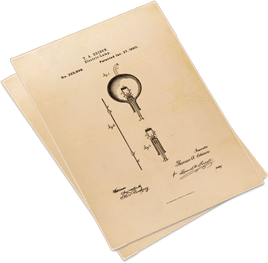A utility patent is granted in return for the disclosure of the invention of something new and useful. Provided that the disclosure fully “teaches” the invention, so that anyone having “ordinary skill” in the field of the invention could make, use, or practice the invention, and provided that the inventor can show that it is both new and useful, few restrictions remain on what may gain patent protection in the United States. In general, patent protection may be granted for practically any novel device or apparatus, material or substance (“composition of matter”), process for making something or making something happen, and most methods for doing useful things. Even non-human living organisms, such as microbes, plants, and animals, may gain utility patent protection to the extent that they are not found in nature in the form or with the properties being patented, that is, are man-made, and can be shown to be useful. Not patentable are abstract ideas, laws of nature, or natural phenomena.
Controversies still exist, however, over what constitutes patentable matter, particularly with respect to processes and methods, and especially regarding chemicals, computer software, and methods of doing business. In the area of chemistry and biochemistry, a chemical formula by itself, like a recipe for lasagna, is generally not patentable, but patent protection may be granted for the novel process of producing a chemical substance defined by a formula, the process of producing a novel chemical substance, or the novel method of using a chemical. The distinction is largely between discovery and invention, particularly with regard to naturally occurring substances. The mere discovery and identification of a new substance in the petal of a flower or the gland of an animal is usually not something that is, in itself, patentable. The question to be answered is how does one make and/or use the newly discovered substance. The process for isolating or extracting the substance, the process of duplicating or synthesizing it, and the method of using it, whether to cure disease or thicken gravy, or a purified substance that does not exist in that form in nature and that is shown to be useful, all of these may achieve patent protection.
Computer software patents have long been the subject of controversy. A computer program is expressed in its source code, using a computer “language,” and, ultimately, in its object code. As expression, the source code and object code are protected by copyright, to the extent they are original, just as any expression in language may be protected. Copyrights in software source code, object code, packages containing the software and its documentation, and, under certain circumstances, the screen displays created by the software may be registered in the Copyright Office. With respect to patentable matter, computer programs embody processes and methods that may be protected by patents, and software that is made part of a machine may create a novel and useful device that is patentable. For example, processes that can be embodied in computer software, such as the processes of compressing computer data that are used for “ZIP” data compression software and the “GIF” image compression format, have obtained utility patent protection. Likewise, logic circuitry — software hard-wired into a computer device (“firmware”) — is also patentable subject matter to the extent that the device, or the process it embodies, is novel and useful.
While processes may comprise patentable matter, independent of the things produced and independent of the devices and materials used by the process, patentable methods have most often been bound to a device or process, as a way of using or doing a tangibly useful thing. Until recently, so-called “methods of doing business,” that is, methods of transforming data – such as methods of marketing, predicting return on investment, teaching, and learning – were not considered patentable. One problem with such methods is in distinguishing the method and its novelty from ordinary activities in its field. Still, originators of such methods have long insisted on the inventiveness of their creations and discoveries, and have sought patent protection, and for the past few decades, U.S. courts have tended to agree with them. In 1998, the Federal Circuit Court of Appeals finally stated clearly and unequivocally that a method of transforming data is patentable, if it produces “a useful, concrete and tangible result”, and thus, the right to obtain utility patent protection for a method of doing business was finally officially recognized.
Patent protection is an exclusionary right. A utility patent does not give the patent holder the right to practice the patented invention, but rather, the right to “exclude others from” making, using, or selling the invention disclosed in the patent in the United States. Similar patent protection is provided by, and may be obtained in, most other countries in the world. The patent term of a U.S. utility patent lasts from the date the patent issues to approximately 20 years from the filing date of the application from which it issues, provided the patent is maintained by payment of the maintenances fees by the end of the fourth, eighth, and twelfth years.


